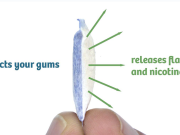More specifically the study indicated that in 2021 about 1 in 20 adults reported being current vapers, while this rate increased among young adults, aged between 18 and 24, with 11% or 1 in 10 reporting vaping.
As expected the popular news sites reporting this data did so in a negative tone which lacked context. Nowhere in sight was there a mention about the fact that this increase in vaping rates has significantly dropped smoking rates.
Here is the context: CDC data from 2022 shows that nearly 2 in every 100 high school students, equating to 2.0% reported smoking in the past 30 days. On the other hand, in 2002 cigarette smoking was the most common type of tobacco use, with 22.5%, that is almost 1 in 4, high school students reporting being current smokers.
Similar pattern documented worldwide
Similarly, data released by the U.K.’s Office for National Statistics (ONS) reported that around 13.3% of people aged 18 or over smoked cigarettes in 2021, as opposed to 14.0% in 2020. This drop coincided with the well documented increase in vaping rates.
The ONS data revealed that 7.7% of those aged 16 and over said they used e-cigarettes compared to 6.4% in 2020. While the relative drop in smoking rates (to 13.3%) is significant given that 20.2% smoked. “This is the lowest proportion of current smokers since 2011, when we began recording smoking prevalence from the annual population survey (APS),” said James Tucker, data and analysis for social care and health division at the ONS.
The ONS reiterated that vaping has played a “major role” in reducing smoking in the UK. Their data indicated that vaping is highest among current smokers at 25.3% and ex-smokers at 15.0%. Only 1.5% of people who have never been smokers are current vapers.
Tobacco harm reduction experts keep highlighting that the shift in the types of nicotine products used by young adults should be celebrated, given the science indicating the relative safety of the products. However anti-vape advocates keep harping on an alleged teen vaping epidemic which studies have shown does not exist. In fact, global data keep indicating that vaping rates are dropping alongside smoking rates.
The U.K. remains ahead of the game
Sadly, the U.K. seems to be one of the very few countries to acknowledge this. In fact last December, the Office of Health Improvement and Disparities, the organisation which replaced Public Health England, released a review on vaping in which it commends its benefits for public health. The Vaping in England review consists of 1,468 pages, and is being considered the most comprehensive vape review yet. It includes significant and reliable evidence on the use of vaping products amongst adults and youth.
The group reiterated that vaping is “at least 95 percent less harmful” than combustible tobacco and “poses only a small fraction of the risks of smoking.” The document also discusses the importance of flavours pointing to “evidence to suggest that non-tobacco flavours, particularly sweet flavours, may play a positive role in helping people switch from smoking to vaping.”
Contrary to advice given by the World Health Organisation (WHO), the document advises smokers to switch completely to vaping products as a way to stop smoking. It adds that accurate information about vaping regarding its relative benefits to smoking should be made available to the public.












